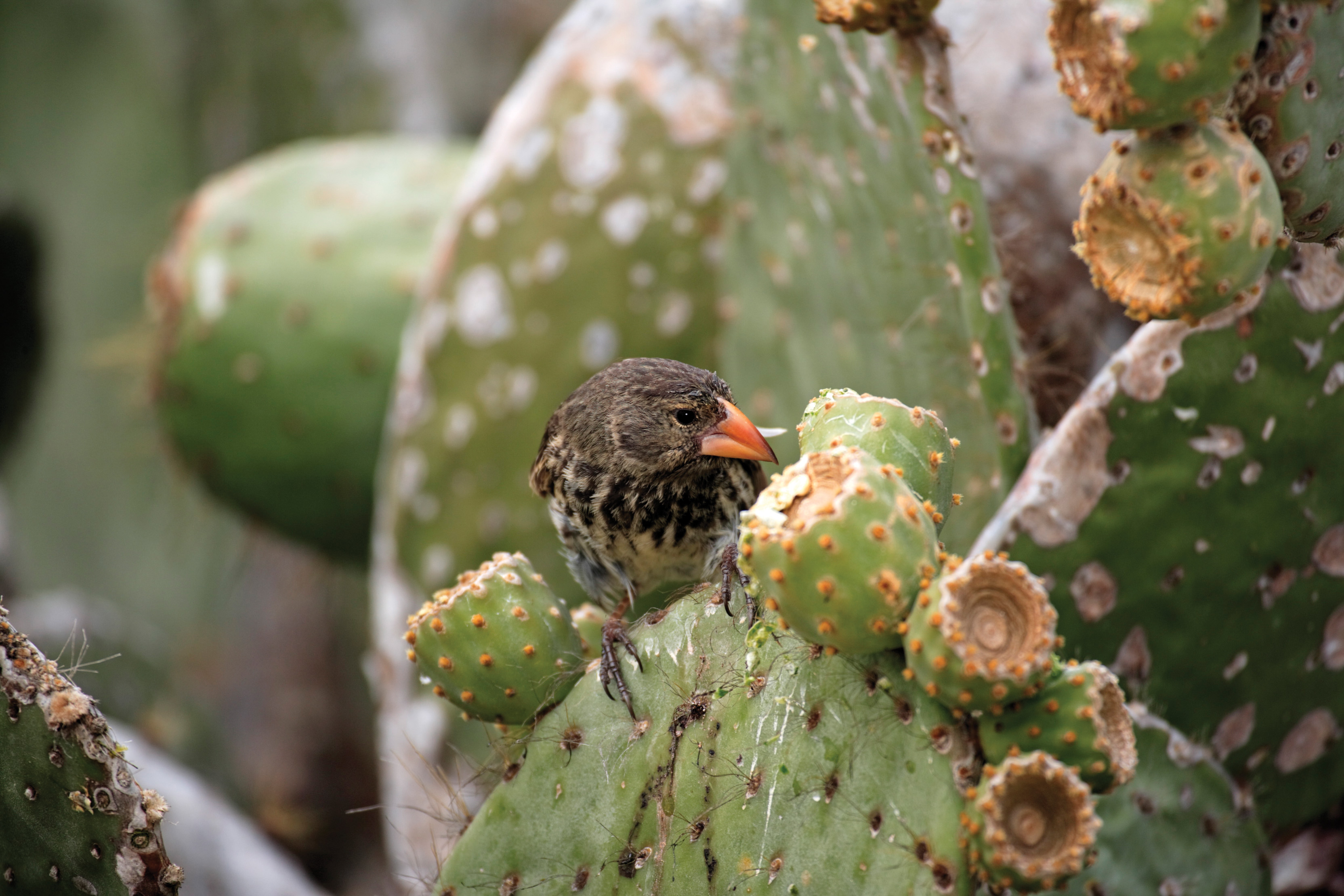Chapter 7
Evolution and Adaptation
160

161
CHAPTER CONCEPTS
- The process of evolution depends on genetic variation.
- Evolution can occur through random processes or through selection.
- Microevolution operates at the population level.
- Macroevolution operates at the species level and higher levels of taxonomic organization.
Darwin’s Finches
As part of his voyage around the world, Charles Darwin spent time exploring the Galápagos Islands, where he collected birds that differed in size and shape. Darwin originally thought that he had collected different families of birds because they resembled finches, blackbirds, and grosbeaks. He shipped the birds back home to England, where ornithologist John Gould determined that the birds were all finches, but finches that looked quite different from each other. Some species ate insects; others ate the fruits and flowers of cacti; still others ate large or small seeds. Darwin hypothesized that these finches likely shared a common ancestor that originally came to the islands from South America. Darwin’s hypothesis—that multiple species could descend from a common ancestor—helped him develop his theory of evolution by natural selection.
“By studying how evolution occurs in wild populations, we have seen that natural selection can alter a population’s traits in a relatively short time.”
Since Darwin’s time, many researchers have gone to the Galápagos Islands to examine how the process of natural selection works in the finches. In the 1970s, for example, Peter and Rosemary Grant marked all of the medium ground finches (Geospiza fortis) on one island and measured their beak sizes. This species of finch eats seeds, and the seed size makes a difference to these birds. Individuals with large beaks can generate the force needed to crack the largest seeds, whereas individuals with small beaks are better at handling the smallest seeds. When the island subsequently experienced a drought, overall seed abundance declined. The small, easy-to-crack seeds were quickly consumed. The large seeds that remained were much harder to crack, so only individuals with larger beaks could crack the large seeds; therefore, birds with larger beaks were more likely to survive the drought. Beak size has a genetic basis that is passed from parents to offspring, and so as the average beak size of parents increased, the beak size of offspring increased. This was evolution in action.
The evolution for large beaks that occurred during the drought was later reversed. In 1983 abundant rainfall caused small seeds to become more plentiful again. Because birds with smaller beaks handled small seeds more efficiently, individuals with smaller beaks survived better and produced more offspring than individuals with larger beaks. Consequently, the average beak size of the population declined. Once again the population evolved in response to a change in the seeds that were available.
Research on the Galápagos finches continues today. In the 1980s another species, the large ground finch (G. magnirostris), arrived from a neighboring island. The large ground finch is nearly twice as big as the medium ground finch and its larger beak is better at cracking large seeds. Over 20 years, the population of large ground finches grew. In 2003, however, another drought hit the island and made seeds scarce once again. Unlike the previous drought where large seeds were the only abundant seeds remaining, now the large ground finches ate most of the large seeds and left only the scarce small seeds for the medium ground finches. With two species now competing for seeds, both suffered very high mortality. Of the medium ground finches that survived, the average beak size was smaller after the drought than before the drought. Thus, the population continued to evolve.
162
The decades of research on Darwin’s finches have provided tremendous insight into how natural selection operates in nature. By studying how evolution occurs in wild populations, we have seen that natural selection can alter a population’s traits in a relatively short time. In this chapter, we will explore the ways in which evolution causes populations to become genetically distinct and how this leads to the origin of new species.
SOURCES: P. R. Grant and B. R. Grant, Evolution of character displacement in Darwin’s finches, Science 313 (2006): 224–226.
E. Pennisi, Competition drives big beaks out of business, Science 313 (2006): 156.
 The story of the finches of the Galápagos Islands demonstrates that evolution shapes the form and function of organisms according to properties of their environments. Evolution depends on genetic variation and this variation can arise from a number of processes. Over time, populations and species can evolve changes in traits, such as the size and shape of bird beaks. These changes can evolve due to random processes or due to the nonrandom process of selection. Some of the most important sources of natural selection include differences in physical conditions, food resources, and interactions with competitors, predators, pathogens, and individuals of the same species. In this chapter, we will examine these processes and explore how genes and the environment come together to cause the evolution of populations and new species.
The story of the finches of the Galápagos Islands demonstrates that evolution shapes the form and function of organisms according to properties of their environments. Evolution depends on genetic variation and this variation can arise from a number of processes. Over time, populations and species can evolve changes in traits, such as the size and shape of bird beaks. These changes can evolve due to random processes or due to the nonrandom process of selection. Some of the most important sources of natural selection include differences in physical conditions, food resources, and interactions with competitors, predators, pathogens, and individuals of the same species. In this chapter, we will examine these processes and explore how genes and the environment come together to cause the evolution of populations and new species.